Design of a Digital Platform for Carbon Generalized System of Preferences Communities Based on the TAO Model of Three-Way Decisions
Abstract
:1. Introduction
2. Literature Review
2.1. Sustainable Development Digital Platform Design
2.2. Community Sustainable Development Platform Design
2.3. Community Carbon Generalized System of Preferences Digital Platform Design
2.4. Research Review
3. Materials and Methods
3.1. Overview of Research Methods
3.2. Genesis and Evolution of the TAO Model
Applicability of the TAO Model
3.3. Carbon Generalized System of Preferences Communities Design
3.3.1. Subject Layer
3.3.2. Instrumental Layer
3.3.3. Application Scenario Layer
3.4. Operational Mechanism of the Carbon Generalized System of Preferences Community Digital Platform Based on the TAO Model
3.4.1. Overall Operational Mechanism
3.4.2. Trisection Operational Mechanism
3.4.3. Action Operational Mechanism
3.4.4. Outcome Operational Mechanism
4. Results
4.1. Procedural Flowchart
4.2. Overall Architectural Design
4.3. Data Flow Diagram Design for the Platform
4.4. Key Technologies of the Platform
4.4.1. Edge Computing Technology: Community Information Monitoring
4.4.2. Blockchain Technology: Platform Information Sharing
4.5. Functional Framework and Interface Design of the Platform
4.6. Experimental Plan
4.6.1. Selection and Construction of the Virtual Platform
4.6.2. Implementation Plan
5. Discussion
5.1. Theoretical and Practical Significance
5.2. Comparison of Community Carbon Generalized System of Preferences and Traditional Carbon Generalized System of Preferences
5.3. Advantages of Applying Three-Way Decision Models to the Community Carbon Generalized System of Preferences
5.4. Research Limitations and Future Directions
6. Conclusions
Author Contributions
Funding
Institutional Review Board Statement
Informed Consent Statement
Data Availability Statement
Conflicts of Interest
References
- United Nations Environment Programme (UNEP). The Emissions Gap Report 2022; United Nations Environment Programme: Nairobi, Kenya, 2022; ISBN 978-92-807-3979-4. [Google Scholar]
- BP. Statistical Review of World Energy 2022; Statistical Review of World Energy 2022 (bp.com); BP: London, UK, 2022. [Google Scholar]
- Xi Jinping’s Speech at the Summit Commemorating the 75th Anniversary of the Founding of the United Nations. Available online: https://m.mofcom.gov.cn/article/i/jyjl/e/202009/20200903003466.shtml (accessed on 13 August 2024).
- Pan, X.; Du, B. Analysis on Legal Problem of Public Participation in the Carbon Generalized System of Preferences Under Carbon Peak and Carbon Neutrality Target. Environ. Prot. 2021, 49, 69–73. [Google Scholar] [CrossRef]
- Si, H.; Li, N.; Duan, X.; Cheng, L.; Bao, Z. Understanding the Public’s Willingness to Participate in the Carbon Generalized System of Preferences (CGSP): An Innovative Mechanism to Drive Low-Carbon Behavior in China. Sustain. Prod. Consum. 2023, 38, 1–12. [Google Scholar] [CrossRef]
- Ma, J. Notice of the State Council on Printing and Distributing the “14th Five-Year Plan” for the Development of the Digital Economy_Macroeconomics_Chinese Government Network; Central People’s Government of the People’s Republic of China: Beijing, China, 2022. [Google Scholar]
- Kaššaj, M.; Peráček, T. Synergies and Potential of Industry 4.0 and Automated Vehicles in Smart City Infrastructure. Appl. Sci. 2024, 14, 3575. [Google Scholar] [CrossRef]
- Yao, Y. Three-Way Decisions and Cognitive Computing. Cogn. Comput. 2016, 8, 543–554. [Google Scholar] [CrossRef]
- Chang, H.H.; Lu, Y.-Y.; Li, P.R. The Yale Model of Green Message Sharing and Environmental Consciousness on Social Media Platforms. OIR 2023, 47, 333–355. [Google Scholar] [CrossRef]
- Hellemans, I.; Porter, A.J.; Diriker, D. Harnessing Digitalization for Sustainable Development: Understanding How Interactions on Sustainability-oriented Digital Platforms Manage Tensions and Paradoxes. Bus. Strat. Environ. 2022, 31, 668–683. [Google Scholar] [CrossRef]
- Da Silveira, A.B.; Levrini, G.R.D.; Ertz, M. How Digital Platforms Materialize Sustainable Collaborative Consumption: A Brazilian and Canadian Bike-Sharing Case Study. J. Int. Consum. Mark. 2022, 34, 51–71. [Google Scholar] [CrossRef]
- Elsharkawy, H.; Rutherford, P. Retrofitting Social Housing in the UK: Home Energy Use and Performance in a Pre-Community Energy Saving Programme (CESP). Energy Build. 2015, 88, 25–33. [Google Scholar] [CrossRef]
- Sui, Y.; Fan, J.; Wang, J.; Liu, S.; Xu, X.; Xu, Z.; Zhang, X.; Xue, N. A Study Based on a Community Smart Sharing House App and Offline Sites. Ind. Eng. Innov. Manag. 2022, 5, 16–20. [Google Scholar] [CrossRef]
- Bidwell, N.J.; Robinson, S.; Vartiainen, E.; Jones, M.; Lalmas, M. Designing Social Media for Community Information Sharing in Rural South Africa. In Proceedings of the Southern African Institute for Computer Scientist and Information Technologists Annual Conference, Centurion, South Africa, 29 September–1 October 2014. [Google Scholar] [CrossRef]
- Ciasullo, M.V.; Troisi, O.; Grimaldi, M.; Leone, D. Multi-Level Governance for Sustainable Innovation in Smart Communities: An Ecosystems Approach. Int. Entrep. Manag. J. 2020, 16, 1167–1195. [Google Scholar] [CrossRef]
- Carroll, J.M.; Beck, J. Sharing Community Data: Platform Collectivism for Managing Water Quality. In The Interplay of Data, Technology, Place and People for Smart Learning; Knoche, H., Popescu, E., Cartelli, A., Eds.; Smart Innovation, Systems and Technologies; Springer International Publishing: Cham, Switzerland, 2019; Volume 95, pp. 62–69. ISBN 978-3-319-92021-4. [Google Scholar]
- Spagnoletti, P.; Resca, A.; Lee, G. A Design Theory for Digital Platforms Supporting Online Communities: A Multiple Case Study. J. Inf. Technol. 2015, 30, 364–380. [Google Scholar] [CrossRef]
- Xue, B.; Zhao, Z.; Li, W. Construction of Public Information Network Platform in Urban Intelligent Communities with Outdoor Activities. In Advances in Future Computer and Control Systems; Jin, D., Lin, S., Eds.; Advances in Intelligent and Soft Computing; Springer: Berlin/Heidelberg, Germany, 2012; Volume 160, pp. 381–387. ISBN 978-3-642-29389-4. [Google Scholar]
- ten Caat, P.N.; Tenpierik, M.J.; Sanyal, T.; Tillie, N.M.J.D.; van den Dobbelsteen, A.A.J.F.; Thün, G.; Cullen, S.; Nakayama, S.; Karanisa, T.; Monti, S. Towards Fossil Free Cities—Emission Assessment of Food and Resources Consumption with the FEWprint Carbon Accounting Platform. Clean. Environ. Syst. 2022, 4, 100074. [Google Scholar] [CrossRef]
- Newton, P.; Schaap, B.; Fournier, M.; Cornwall, M.; Rosenbach, D.W.; DeBoer, J.; Whittemore, J.; Stock, R.; Yoders, M.; Brodnig, G.; et al. Community Forest Management and REDD+. For. Policy Econ. 2015, 56, 27–37. [Google Scholar] [CrossRef]
- Guzman, L.; Makonin, S.; Clapp, A. CarbonKit: Designing A Personal Carbon Tracking Platform. In Proceedings of the Fourth International Workshop on Social Sensing, Montreal, QC, Canada, 15 April 2019; pp. 24–29. [Google Scholar] [CrossRef]
- Yamagata, Y.; Murakami, D.; Wu, Y.; Yang, P.P.-J.; Yoshida, T.; Binder, R. Big-Data Analysis for Carbon Emission Reduction from Cars: Towards Walkable Green Smart Community. Energy Procedia 2019, 158, 4292–4297. [Google Scholar] [CrossRef]
- Web-Based Platform for the Management of Citizen Energy Communities and Their Members|Energy Informatics|Full Text. Available online: https://energyinformatics.springeropen.com/articles/10.1186/s42162-021-00155-7 (accessed on 13 August 2024).
- Ugwoke, B.; Corgnati, S.P.; Leone, P.; Borchiellini, R.; Pearce, J.M. Low Emissions Analysis Platform Model for Renewable Energy: Community-Scale Case Studies in Nigeria. Sustain. Cities Soc. 2021, 67, 102750. [Google Scholar] [CrossRef]
- Hanna, R. Energy Transition Platform Policy Briefing; Community Renewables Innovation Lab.: London, UK, 2017. [Google Scholar]
- Yao, Y. Three-Way Decision and Granular Computing. Int. J. Approx. Reason. 2018, 103, 107–123. [Google Scholar] [CrossRef]
- Yao, Y. Three-Way Decisions with Probabilistic Rough Sets. Inf. Sci. 2010, 180, 341–353. [Google Scholar] [CrossRef]
- Jiang, C.; Guo, D.; Sun, L. Effectiveness Measure for TAO Model of Three-Way Decisions with Interval Set. IFS 2021, 40, 11071–11084. [Google Scholar] [CrossRef]
- Guo, D. The TAO Model and Acting Measures of Three-Way Decision under Granular Computing Perspective. Master’s Thesis, Harbin Normal University, Harbin, China, 2021. [Google Scholar]
- Hu, X.; Cui, Y. IIGF Perspectives|The Development Status of the Carbon Inclusive Mechanism and Suggestions for Its Improvement. Available online: https://iigf.cufe.edu.cn/info/1012/6838.htm (accessed on 15 August 2023).
- Chen, F.; Chen, Q.; Hou, J.; Li, S. Effects of China’s Carbon Generalized System of Preferences on Low-Carbon Action: A Synthetic Control Analysis Based on Text Mining. Energy Econ. 2023, 124, 106867. [Google Scholar] [CrossRef]
- GB/T 50331; Urban Residential Water Use Standard. Ministry of Construction of the People’s Republic of China: Beijing, China, 2002.
- GB/T 50293-2014; Code for Planning of Urban Electric Power. Ministry of Construction of the People’s Republic of China: Beijing, China, 2014.
- GB/T 50293-2014; Code for Planning of City Gas. Ministry of Construction of the People’s Republic of China: Beijing, China, 2014.
- Analysis of Green Mobility and Carbon Emissions in Chinese Cities; Beijing Digital City Future Technology Co.: Beijing, China, 2023.
- Center for Public Environmental Research CPCD, China Products Carbon Footprint Factors Database. Available online: https://lca.cityghg.com/ (accessed on 13 February 2024).
- State Post Bureau of The People’s Republic of China. China Express Development Index. Available online: https://www.spb.gov.cn/gjyzj/c100278/common_list.shtml (accessed on 8 August 2024).
- Digital Carbon Neutral Special Fund of China Internet Development Foundation; China Central Joint Certification Center (CCJCC). Tencent CEPA. In Study on Carbon Emission Reduction Performance of Online Document Products; Tencent: Shenzhen, China, 2022. [Google Scholar]
- Publicity and Education Center of the Ministry of Ecology and Environment. Online Conference Helps Quantify Carbon Reduction Study; Ministry of Ecology and Environment: Beijing, China, 2022. [Google Scholar]
- China’s Major Cities Commuting Monitoring Report 2023; China Academy of Urban Planning and Design: Beijing, China, 2023.
- Dietary Guidelines for Chinese Residents 2022; Chinese Nutrition Society: Beijing, China, 2022.
- A Comparative Study of Greenhouse Gas Emissions from Online and Offline Shopping in China; Energy Foundation: Beijing, China, 2021.
- Cajková, A.; Jankelová, N.; Masár, D. Knowledge Management as a Tool for Increasing the Efficiency of Municipality Management in Slovakia. Knowl. Manag. Res. Pract. 2023, 21, 292–302. [Google Scholar] [CrossRef]
- Liu, Y.; Bin, Y.; Chen, N.; Zhu, S. Caching Placement Optimization Strategy Based on Comprehensive Utility in Edge Computing. Appl. Sci. 2023, 13, 9229. [Google Scholar] [CrossRef]
- Alzhrani, F.; Saeedi, K.; Zhao, L. Architectural Patterns for Blockchain Systems and Application Design. Appl. Sci. 2023, 13, 11533. [Google Scholar] [CrossRef]
- Zhang, H.; Zhang, J.; Wang, R.; Huang, Y.; Zhang, M.; Shang, X.; Gao, C. Smart Carbon Monitoring Platform under IoT-Cloud Architecture for Small Cities in B5G. Wirel. Netw. 2024, 30, 3837–3853. [Google Scholar] [CrossRef]
- Lai, Z.; Cui, Y.; Zhao, T.; Wu, Q. Design of Three-Dimensional Virtual Simulation Experiment Platform for Integrated Circuit Course. Electronics 2022, 11, 1437. [Google Scholar] [CrossRef]
- Tencent Carbon BASE. Available online: https://tanbase.tencent.com/home (accessed on 13 August 2024).
- Oh, H.; Jun, S.; Kim, J.Y.; Chu, H.-Y. Korea’s Emissions Trading System for Low-Carbon Energy and Economic Transformation: A Quantitative Study Evaluating the Impact of Phase I of the KETS on Energy Efficiency and the Energy Mix. Energy Effic. 2023, 16, 13. [Google Scholar] [CrossRef]
- Ministry of Environment, Korea South Korea|Climate Action Tracker. Available online: https://climateactiontracker.org/countries/south-korea/ (accessed on 13 August 2024).
- Akao, K.-I. An Economic Analysis of the “Home Appliance Eco-Point System” in Japan. Environ. Econ. Policy Stud. 2017, 19, 483–501. [Google Scholar] [CrossRef]
- Owen, A.; Barrett, J. Reducing Inequality Resulting from UK Low-Carbon Policy. Clim. Policy 2020, 20, 1193–1208. [Google Scholar] [CrossRef]
- Ravigné, E.; Ghersi, F.; Nadaud, F. Is a Fair Energy Transition Possible? Evidence from the French Low-Carbon Strategy. Ecol. Econ. 2022, 196, 107397. [Google Scholar] [CrossRef]
- Shirizadeh, B.; Quirion, P. Low-Carbon Options for the French Power Sector: What Role for Renewables, Nuclear Energy and Carbon Capture and Storage? Energy Econ. 2021, 95, 105004. [Google Scholar] [CrossRef]
- Xiao, Y.-H.; Jiang, Y.-P.; Du, M.; Gan, S.-J.; Tan, Z.-T.; Tan, X.-X.; Zhang, M.; Wu, X.-B. A New Carbon Emission Reduction Mechanism: Carbon Generalized System of Preferences (CGSP). Environ. Sci. Pollut. Res. 2021, 28, 1267–1274. [Google Scholar] [CrossRef]
- Li, W.; Liu, J. Investigating Public Support for the Carbon Generalized System of Preference through the Lens of Protection Motivation Theory and Information Deficit Model. Sustainability 2024, 16, 1531. [Google Scholar] [CrossRef]
- Li, S.; Ji, L.; Wang, Y.; Zhou, X.; Wang, X.; Jiang, S.; Sun, Q. Can China’s Carbon Generalized System of Preferences Reduce Urban Residents’ Carbon Emissions? Evidence from a Quasi-Natural Experiment. J. Environ. Manag. 2024, 362, 121222. [Google Scholar] [CrossRef] [PubMed]
- Suo, L.; Yang, H.; Li, Q.; Yang, H.-L.; Yao, Y. A Review of Three-Way Decision: Triadic Understanding, Organization, and Perspectives. Int. J. Approx. Reason. 2024, 2024, 109268. [Google Scholar] [CrossRef]
- Tang, Y.; Qiao, J. Three-Way Decision Method Based on Triangular Norms in Incomplete Information Systems and Its Applications in Medical Diagnosis. Appl. Soft Comput. 2024, 159, 111657. [Google Scholar] [CrossRef]
- Song, J.; Leng, X.; Liu, Z. Green Supplier Selection Based on Sequential Group Three-Way Decision Making. Mathematics 2023, 11, 4605. [Google Scholar] [CrossRef]
- Jiang, C.; Wu, J.; Li, Z. Adaptive Thresholds Determination for Saving Cloud Energy Using Three-Way Decisions. Clust. Comput. 2019, 22, 8475–8482. [Google Scholar] [CrossRef]
- Flaut, D.; Hošková-Mayerová, Š.; Ispas, C.; Maturo, F.; Flaut, C. (Eds.) Decision Making in Social Sciences: Between Traditions and Innovations; Studies in Systems, Decision and Control; Springer: Cham, Switzerland, 2020; ISBN 978-3-030-30658-8. [Google Scholar]

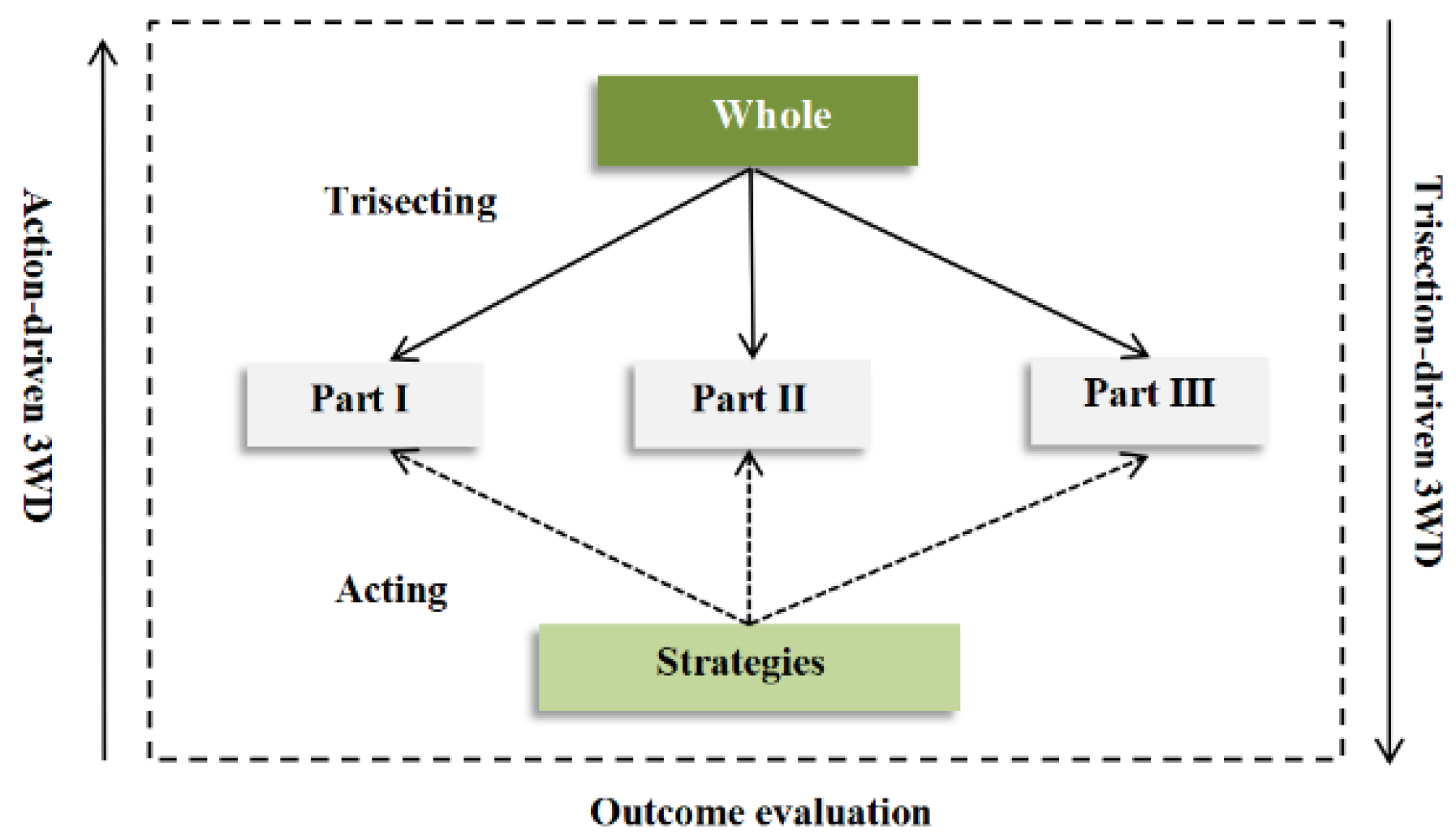
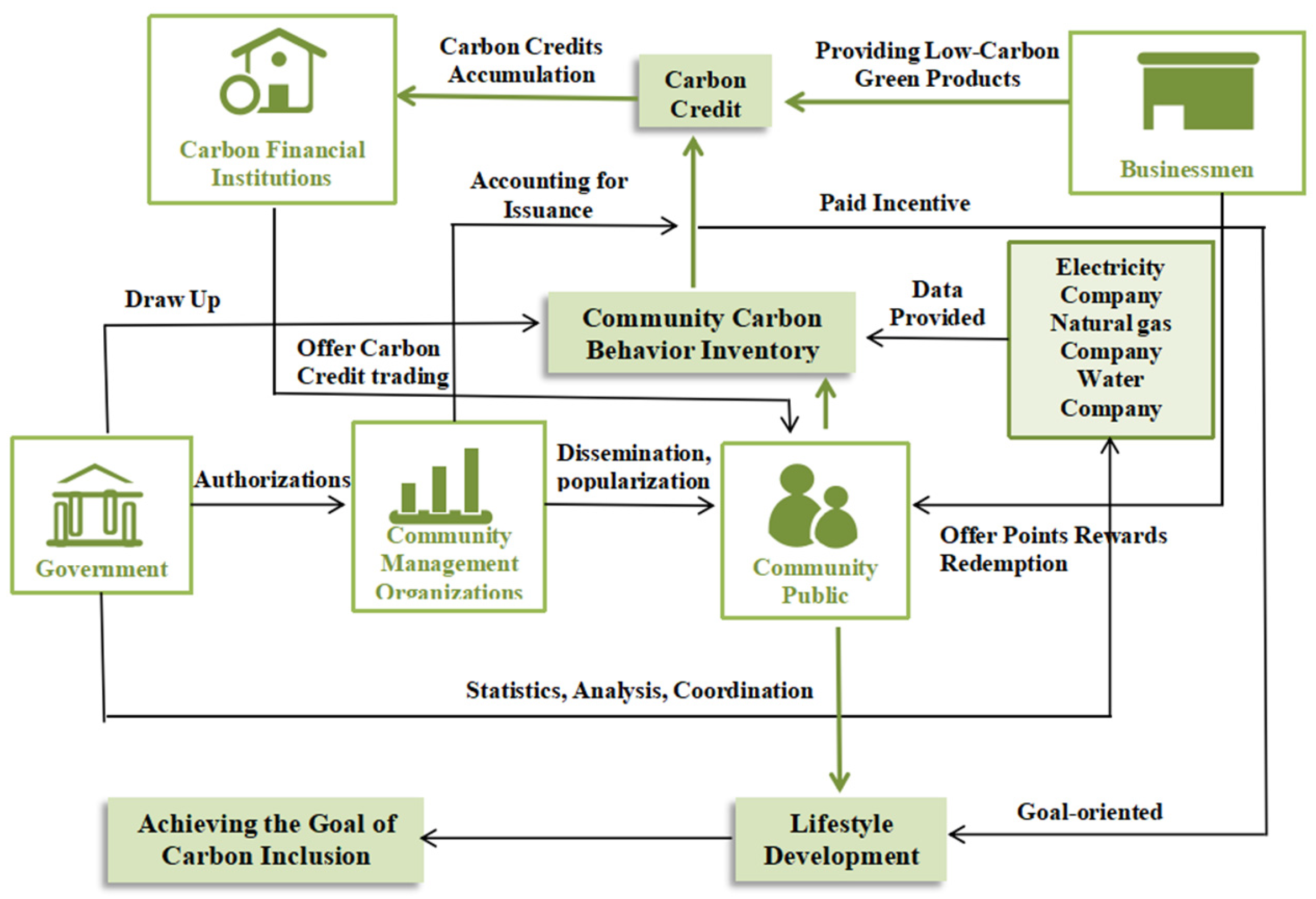
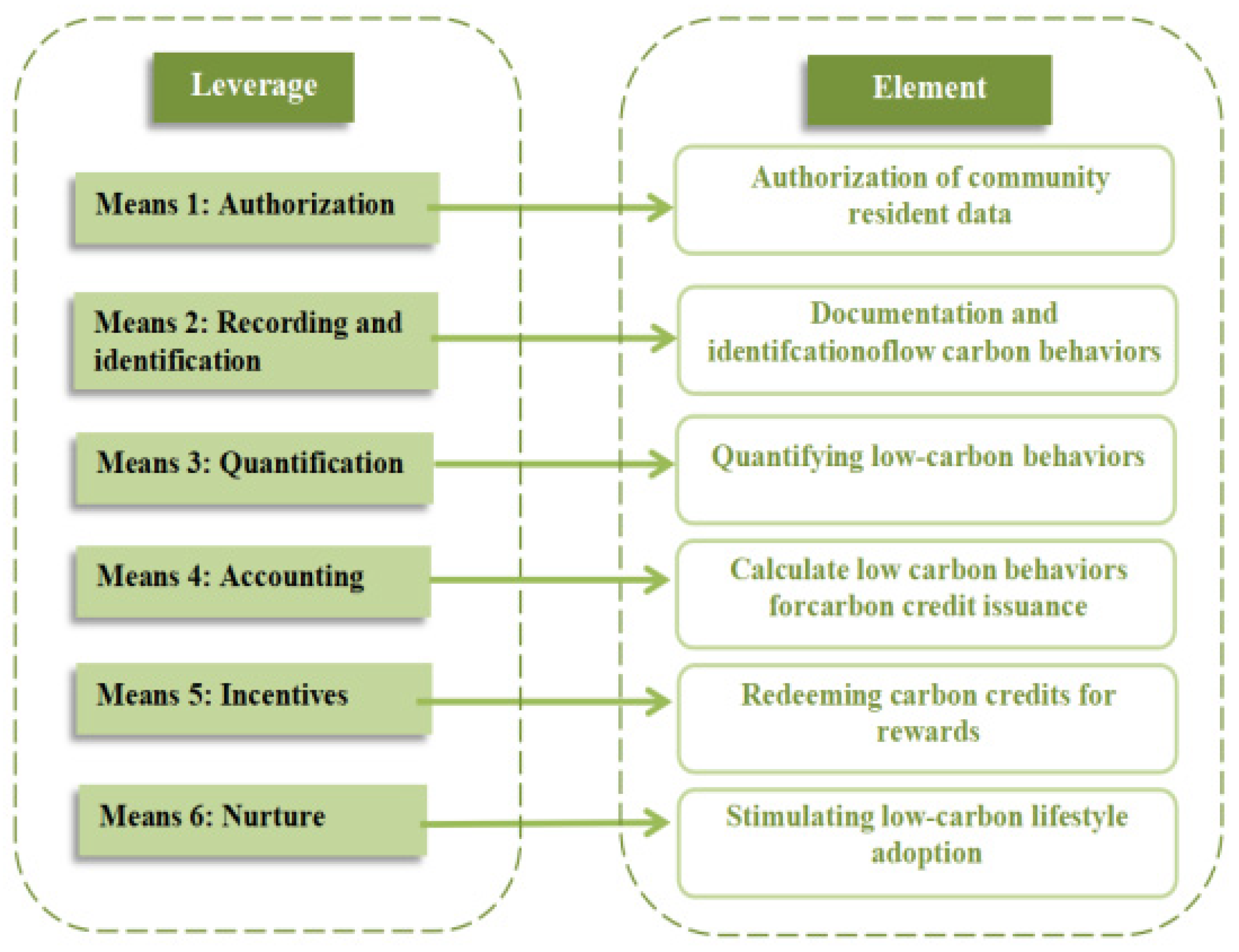

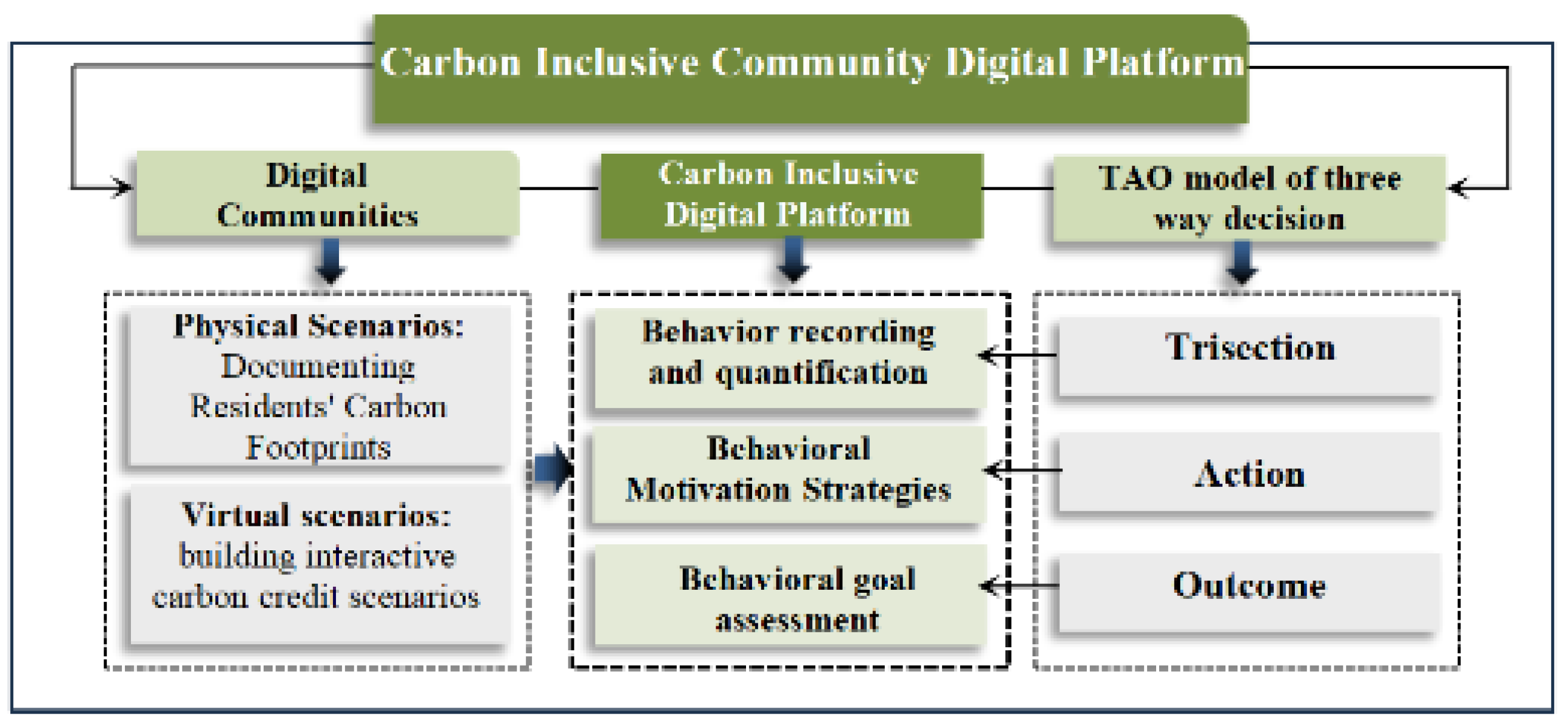


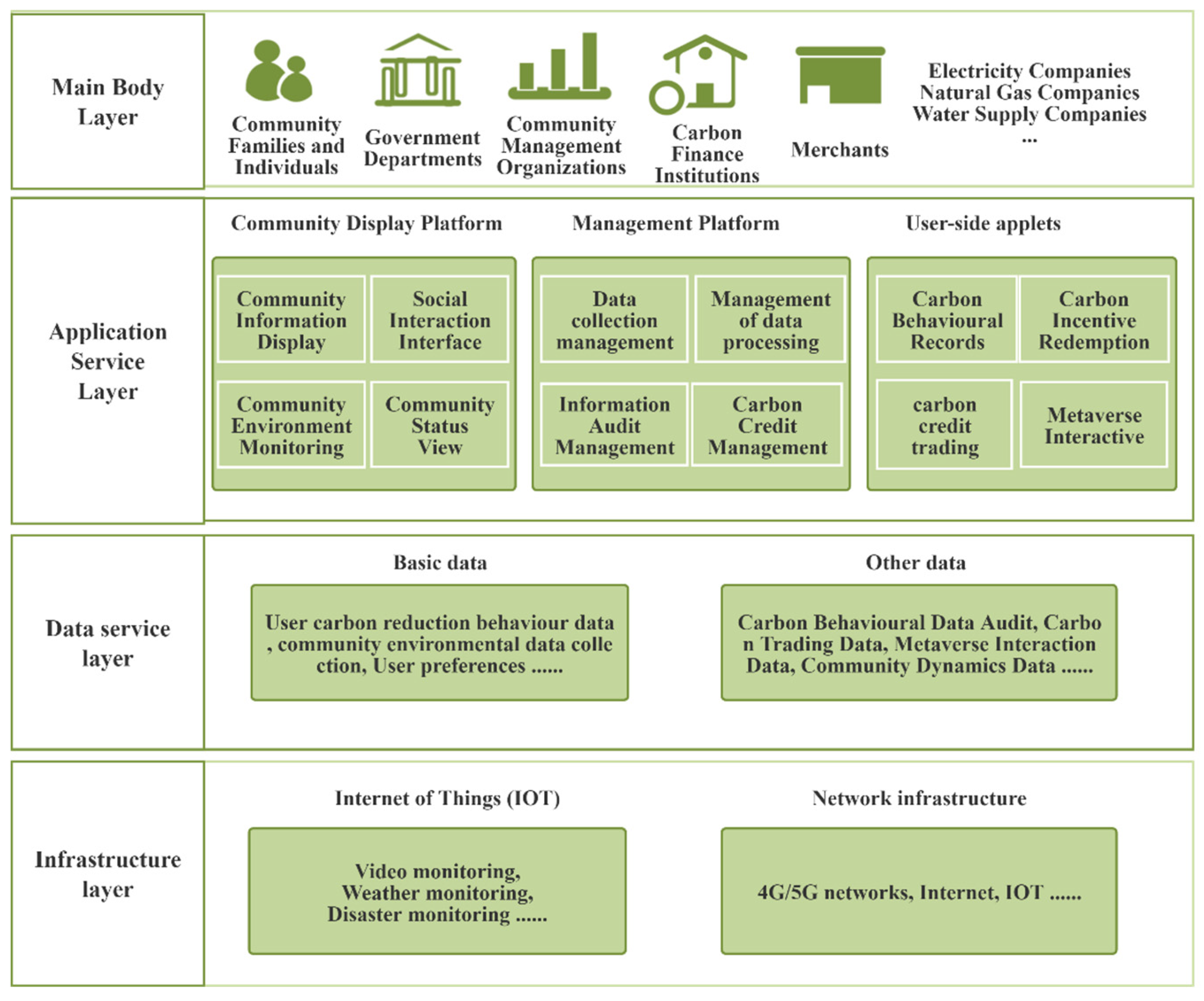
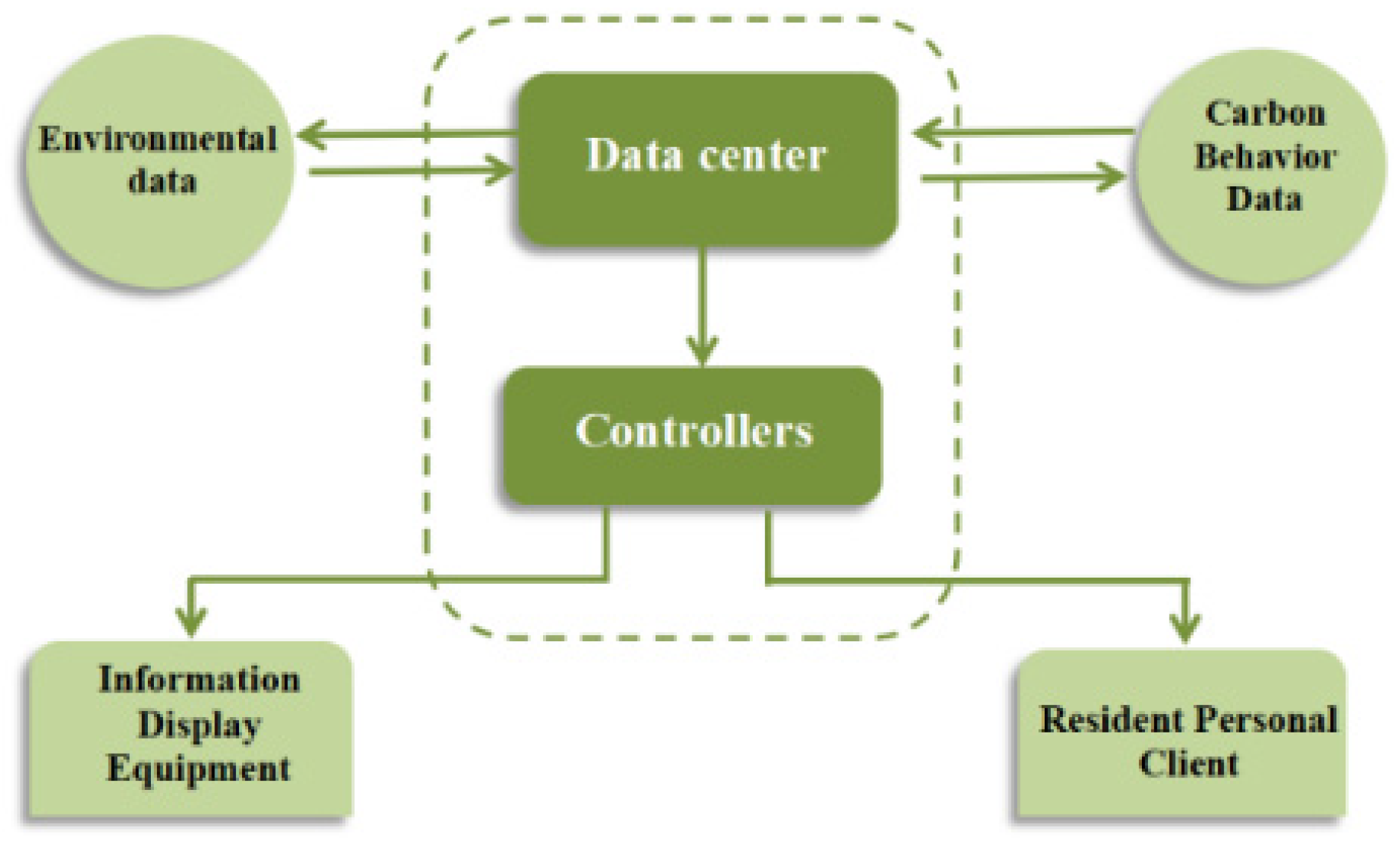

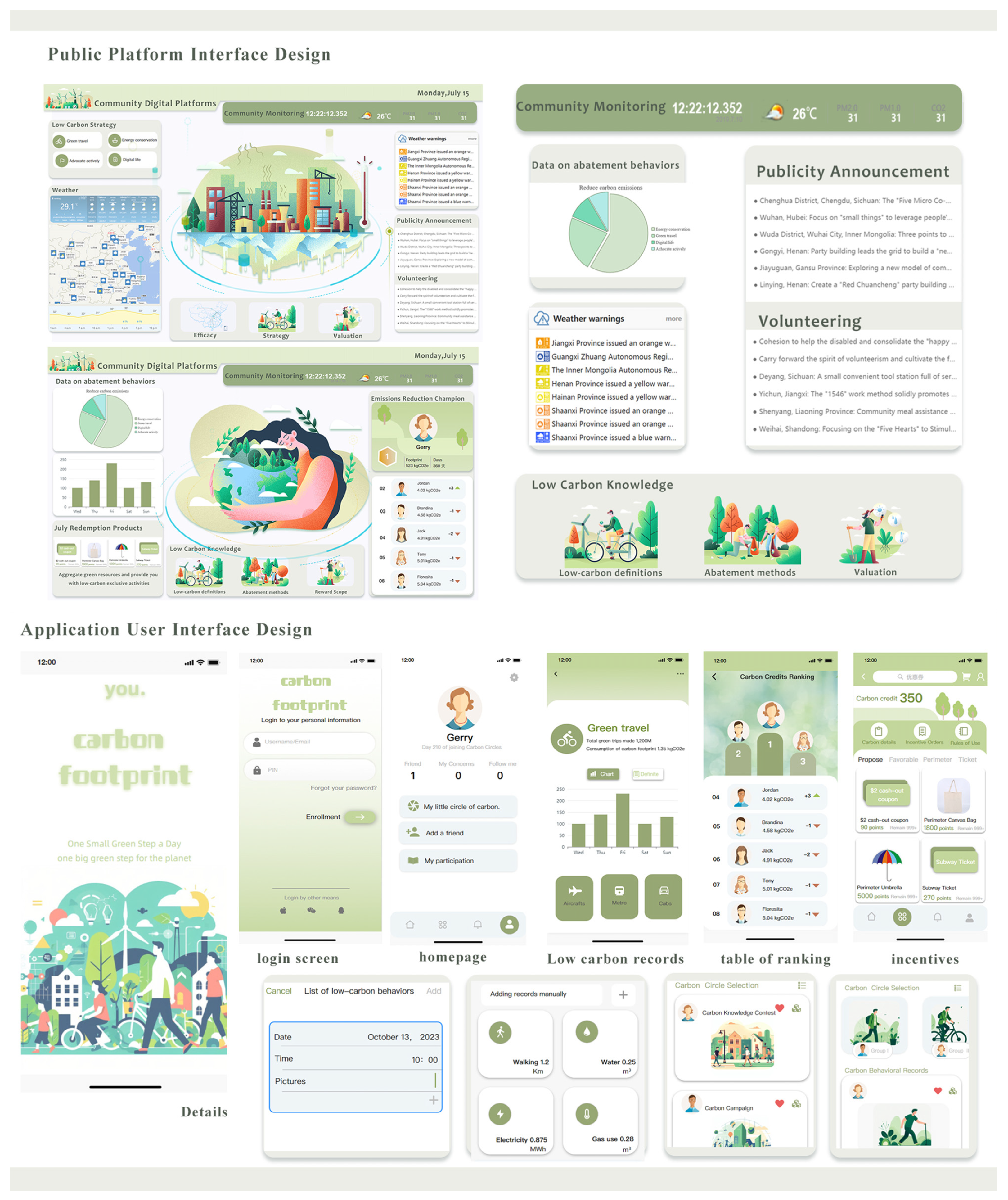

| Community Behavior Inventory | Carbon Footprint (kgCO2e) | Wt. | Acq. Meth. | Acq. Path. | Pos. Dom. | Neg. Dom. | Bnd. Dom. | Main Activity Level Data Unit | Reference | |
|---|---|---|---|---|---|---|---|---|---|---|
| Energy Saving and Emission Reduction A Energy Conservation and Emission Reduction A | Water Saving a1 | 0.820 | 10% | Dir. Acq. | Water Company | 2.460 | 3.81 | (2.46, 3.81) | Cubic Meters per Capita per Month | Urban Residential Water Use Standard GB/T 50331—2002 [32] |
| Electricity Saving a2 | 0.581 | 20% | Dir. Acq. | Power Supply Bureau | 0.120 | 0.21 | (0.12, 0.21) | Megawatt-hours per Household per Month | Residential Electricity Retail Price List [33] | |
| Gas Saving a3 | 0.017 | 10% | Dir. Acq. | Gas Company | 0.600 | 0.94 | (0.60, 0.94) | Cubic Meters per Household per Month | Residential Household General Living Gas Tiered Quantity and Price Table [34] | |
| Green Transport-action B | Transportation b1 | 0.070 | 20% | Ind. Acq. | Transportation Platform Data Center | 16.800 | 123.900 | (16.800, 123.900) | Kilometers per Person per Month | Green Transportation Action Plan Creation [35] |
| 0.513 | ||||||||||
| Proactive Advocacy C | Plastic Recycling c1 | 0.906 | 7.5% | Ind. Acq. | User Upload | 6.800 | 2.270 | (2.270, 6.800) | Kilograms per Person per Month | China Product Life Cycle Greenhouse Gas Emission Coefficient Database [36] |
| Food Waste c2 | −0.810 | 7.5% | Ind. Acq. | User Upload | 2.620 | 1.310 | (2.600, 1.310) | Kilograms per Person per Month | ||
| Diet Advocacy c3 | 0.540 | 10% | Ind. Acq. | User Upload | 17.570 | 40.670 | (17.580, 40.680) | Kilograms per Person per Month | ||
| 2.464 | ||||||||||
| Digital Living D | Online Shopping d1 | 0.581 | 5% | Ind. Acq. | Shopping Platform Upload | 5.470 | 6.800 | (5.470, 6.800) | Kilometers per Person per Month | China Express Logistics Industry Data [37] |
| Remote Work d2 | 0.581 | 5% | Ind. Acq. | User Upload | 0.002 | 0.085 | (0.002, 0.085) | Megawatt-hours per Person per Month | Online Conference Carbon Reduction Research Reports [38] | |
| Online Meetings d3 | 0.610 | 5% | Ind. Acq. | User Upload | 0.013 | 11.950 | (0.013, 11.950) | Megawatt-hours per Person per Month | Online Document Product Carbon Reduction Performance Study [39] | |
| Total Value Division Z | Comprehensive calculations | 5.010 | 30.040 | (5.01, 30.04) | ||||||
| Equation | ||||||||||
| Objective Layer | Criteria Layer | Wt. (%) | Indicator Layer | Wt. (%) | Indicator Direction |
|---|---|---|---|---|---|
| Community Carbon Generalized System of Preferences Benefit Evaluation Indicator System | Transportation System | 13.4 | Community Per Capita Private Car Ownership (vehicles/person) | 2.33 | Negative |
| Proportion of New Energy Vehicles | 3.94 | Positive | |||
| Proportion of Low-Carbon Commuters in the Community | 7.15 | Positive | |||
| Energy System | 18.50 | Annual Electricity Consumption in the Community | 3.86 | Negative | |
| Annual Water Consumption in the Community | 4.61 | Negative | |||
| Number of Household Appliances with Energy Efficiency Labels | 3.39 | Positive | |||
| Number of Solar-Powered Household Appliances | 6.64 | Positive | |||
| Technology System | 16.25 | Waste Sorting Collection Rate | 4.97 | Positive | |
| Harmless Treatment Rate of Household Waste | 5.43 | Positive | |||
| Number of Interactions with Community Display Devices | 2.58 | Positive | |||
| Digital Technology Adoption Rate | 3.27 | Positive | |||
| Environmental System | 25.24 | Community Green Coverage Rate | 7.54 | Positive | |
| Per Capita Green Area | 8.80 | Positive | |||
| Number of Days with Air Quality Level Two or Above in the Community Throughout the Year | 8.90 | Positive | |||
| Institutional System | 26.60 | Carbon Generalized System of Preferences Knowledge Dissemination Rate | 4.39 | Positive | |
| Residents’ Low-Carbon Awareness Acceptance | 4.64 | Positive | |||
| Completeness of Residents’ Carbon Trading Platform | 6.44 | Positive | |||
| Participation Level in Residents’ Low-Carbon Community Construction | 7.24 | Positive | |||
| Satisfaction with Residents’ Low-Carbon Community Construction | 3.90 | Positive |
Disclaimer/Publisher’s Note: The statements, opinions and data contained in all publications are solely those of the individual author(s) and contributor(s) and not of MDPI and/or the editor(s). MDPI and/or the editor(s) disclaim responsibility for any injury to people or property resulting from any ideas, methods, instructions or products referred to in the content. |
© 2024 by the authors. Licensee MDPI, Basel, Switzerland. This article is an open access article distributed under the terms and conditions of the Creative Commons Attribution (CC BY) license (https://creativecommons.org/licenses/by/4.0/).
Share and Cite
Wei, H.; Yang, C.; Wen, C.; Wang, Y. Design of a Digital Platform for Carbon Generalized System of Preferences Communities Based on the TAO Model of Three-Way Decisions. Appl. Sci. 2024, 14, 7423. https://doi.org/10.3390/app14167423
Wei H, Yang C, Wen C, Wang Y. Design of a Digital Platform for Carbon Generalized System of Preferences Communities Based on the TAO Model of Three-Way Decisions. Applied Sciences. 2024; 14(16):7423. https://doi.org/10.3390/app14167423
Chicago/Turabian StyleWei, Huilan, Chendan Yang, Chuanye Wen, and Yanlong Wang. 2024. "Design of a Digital Platform for Carbon Generalized System of Preferences Communities Based on the TAO Model of Three-Way Decisions" Applied Sciences 14, no. 16: 7423. https://doi.org/10.3390/app14167423






